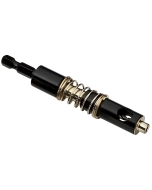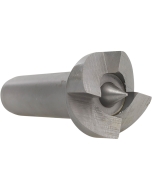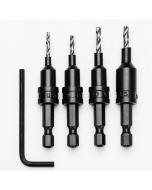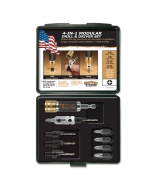Video: Top 5 Drill Bits for Woodworking Projects

Today I'm going to show you five different types of drill bits that are especially useful to woodworkers. Whether you're new to woodworking or have years of experience, you're going to want these drill bits in your tool collection.
Skill Builder Video
Top 5 Drill Bits for Woodworking Projects - Video Transcript
When most people think of drill bits, the common twist bit is what they envision. These bits feature two spiraling channels called flutes, with sharp tapered cutting edges at the end of the flutes. Twist bits are great all-around drill bits. They're good for cutting most materials, including wood, plastic and metal. A couple negative considerations, mainly for larger diameter twist bits, are that they tend to tear the wood, leaving a ragged entry hole. They also will wander if there's not a good starter hole to guide them, especially when drilling at angles.
Brad point bits look a lot like twist bits at first glance, but a closer look reveals some key differences that make them more useful in many woodworking applications. First, you'll notice the sharp spur at the tip of the bit. This spur makes it easy to center the bit after marking a hole location. Next, you'll notice a couple sharp spurs at the tips of the flutes. These spurs cleanly shear the perimeter of the hole and the flutes remove the chips. Brad point bits are best for drilling perpendicular holes and they leave a nice, clean entry. They can jump out of alignment when starting angled holes. They also aren't recommended for making existing holes larger because the spur can be difficult to center in the existing hole. The tapered tip of a twist bit is easier to center in these applications.
Forstner bits are the perfect bit for boring clean, flat-bottom holes, especially large diameter holes for applications like European hinges. These bits are also great for boring overlapping holes such as a mortise. These bits feature a cutting edge around the perimeter and a couple cutters that shear the wood and leave a flat-bottom hole. If you bore deep holes, you'll need to use a vacuum to remove the chips and keep it from clogging around the bit. Larger forstner bits often feature a jagged perimeter cutting edge. These are more aggressive and intended to more quickly bore large holes. Combination countersink bits combine a twist bit for drilling a pilot hole and a countersink to create the tapered recess for the screw head, all in one operation. The twist bit component is often tapered to work well with tapered wood screws. These bits are available in a variety of sizes to match the size of the screw you're using. Self-centering bits make it easy to drill pilot holes when you're installing hardware. These special bits feature a small twist bit that is inside a spring-loaded sleeve. The sleeve is tapered at the end to center itself in hardware holes. These bits come in a variety of sizes and make boring hinge holes a snap.
There you have it, the five most useful bits for woodworkers. Now, there are lots of other specialty bits out there that you'll need for specific projects, such as pocket hole joinery, but if you've got these five bits in your workshop, they'll cover most of the holes you need to drill and they'll ensure great results.
Keep the inspiration coming!
Subscribe to our newsletter for more woodworking tips and tricks



